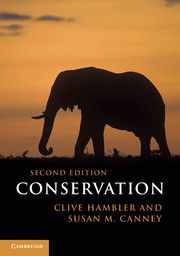Book contents
- Frontmatter
- Contents
- Preface to the Second Edition
- 1 Introduction to conservation
- 2 Threats to biodiversity
- 3 Evaluation of priorities for species and habitats
- 4 Monitoring and Environmental Impact Assessment
- 5 Management of natural and fragmented habitats
- 6 Management of species
- 7 Sustainable use, semi-natural cultural landscapes and the matrix
- 8 Restoration and offsetting
- 9 Environmental policy
- References
- Index to species names
- Index
- Plate section
3 - Evaluation of priorities for species and habitats
Published online by Cambridge University Press: 05 February 2013
- Frontmatter
- Contents
- Preface to the Second Edition
- 1 Introduction to conservation
- 2 Threats to biodiversity
- 3 Evaluation of priorities for species and habitats
- 4 Monitoring and Environmental Impact Assessment
- 5 Management of natural and fragmented habitats
- 6 Management of species
- 7 Sustainable use, semi-natural cultural landscapes and the matrix
- 8 Restoration and offsetting
- 9 Environmental policy
- References
- Index to species names
- Index
- Plate section
Summary
Conservationists want to use their limited available funds in the most effective ways; however, this is not always straightforward given the complexity of the natural world, imperfect knowledge and the range of perceptions. This chapter documents the considerations that help guide decisions over priorities, and is also pertinent to the Convention on Biological Diversity process which requires signatories to identify priority species and habitats.
It is important to recognise that all decisions about priorities are partly subjective, as people differ in personal values, perspectives and motives. It is therefore essential to define the aims and their relative importance before any evaluation. It is also important to be aware of the scale of operation – local, regional or global – as priorities will change accordingly. Once the aims are explicit, transparent and clear, ecologists or other interested parties can often provide rankings of priority species or habitats, using quantitative ecological methods (Chapter 4). They can also manage sites with a clear vision as to the desired result.
Historically, conservation often focused on species – for hunting or for their attractiveness. This has expanded recently to include bundles of related species with similar biology or groups of unrelated species that use similar habitats. There is growing concern for ecosystem processes (services), which requires evaluation and planning on a larger scale and can require conservation of groups of species. The longstanding interest in wilderness and national parks has emphasised landscape conservation and has been reinforced by motivation to conserve habitats or whole ecosystems for the sake of the many species and genes within them.
- Type
- Chapter
- Information
- Conservation , pp. 87 - 124Publisher: Cambridge University PressPrint publication year: 2013



